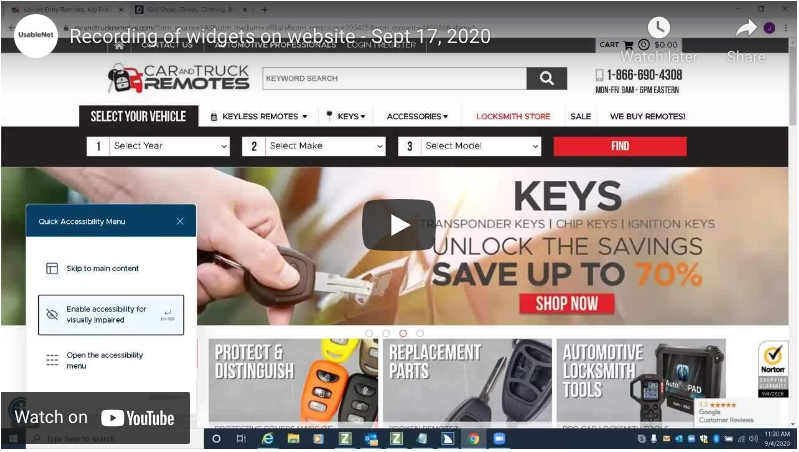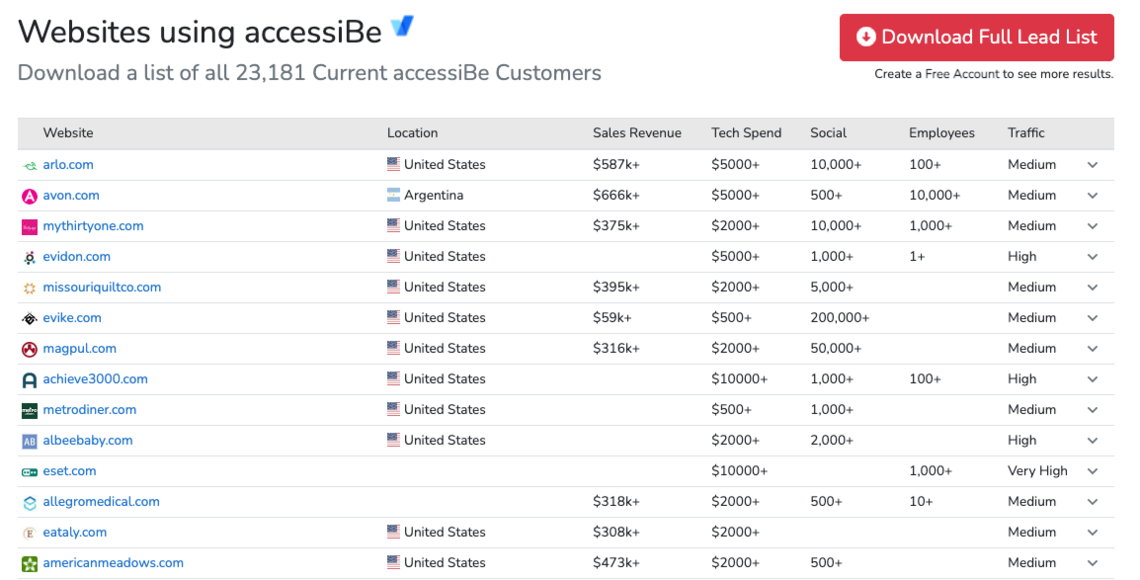
Why Website Accessibility Overlay Widgets & Plugins Fail Compliance
We regularly update this post because information is continously suracing showing how accessibiilty overlay widgets fail to provide meaningful accessibility or legal ADA compliance protection. While awareness is growing, we still get frequent inquiries from companies that have been sued while using an overlay.
A key claim is that their AI POWERED widgets provide ADA compliance and lawsuit protection. Yet according to UsableNet's 2023 Digital Accessibility Lawsuit Report, the number of lawsuits last year that involved an overlay rose 60%. In fact, this report found that 30% of all state and federal lawsuit were connected to these overlays.
Meanwhile these overlay companies continue their aggressive false ad campaigns, and aggressive litigation against those that call them out. And unknowing companies continue to take what appears to be the cheap and easy way, only to discover what an expensive mistake that often is.
So. Unless you want to add to next year's lawsuit statistics, do not use an overlay.
What Are Accessibility Overlay Widgets?
Overlay "accessibility solutions" are automated software solution that claims to be capable of not only detecting but also "fixing" ADA violations. However, it has been widely accepted (even in AI 2024 still) even the best automated software can only detec ~30% of Web Content Accessibility Guidelines issues in the first place. The WCAG is the international standard for web accessibility and is applied to both federal ADA/508 and growing state laws.
So what these overlay "solutions" do is add a layer of code over the site that masks errors but only addresses the basic accessibility issues it can detect. This is like putting a bandaid over a shark bite and calling it a day.
On many websites using an overlay, you might notice a round “accessibility button” hanging in the footer. The button typcially opens a toolbar with options such as
- Text adjustments - size, spacing, alignment
- Color - contrast, saturation, monochrome
- Adjust curser
- Add focus states
- Magnify
- Screen reader in some cases
Many incorporate Artificial Intelligence (everyone's favorite buzzword), to interpret images and automagically add alt tags, which are labels that describe images. However, as you might guess, accuracy and usefulness for the actual person using a screen reader is low.
Hear from a user's perspective:
Blind User: "Avoid AccessiBe & other companies claiming quick & easy AI accessibility.
Will Using an Accessibility Overlay Widget Make My Website WCAG or ADA Compliant?
Is this a rhetorical question? Even with 2024 AI, no overlay widget can currently make a website WCAG compliant - in 48 hours or 48 days. Consider the fundamental point that there is no automated tool, software, plugin, widget, or app that can even detect much better than 30% of WCAG issues. So how could any overlay company make this claim? Well, let's not let the truth get in the way of making a pile of cash.
With that fundamental point firmly established here are are additional reasons why overlays fail to provide legal protection, compliance or significant accessibility improvements for real people with disabilities.
The Core Website Code & Violations Remain Legally Exposed
The overlay adds a transparent layer to address certain issues but the underlying code is fully exposed to legal trolls to identify violations.
Website Overlay Solutions Lack Manual Human Testing and actual Remediation
As already stated, they’re automated, so they miss 70% of WCAG issues. How can any solution claim to solve only 100% of the issues if it can only detect 30%? The remaining 70% can only be assessed through human manual testing. Some providers do claim to provide manual testing and remediation, however the remediation is only applied to the overlay layer, not the underlying code left exposed.
Overlays Affect the Users’ Existing Assistive Technology Tools
This is the most significant. Any person with a disability has their favorite set of tools and browser settings already tuned and learned. Forcing a user with disabilities to scrap their tools to then study, learn and customize this new set of toolbar options for each website they visit is a serious barrier. So they really don’t work for the actual people with disabilities. They only serve the interests of the website owner looking to avoid the expense of proper website accessibility.
Overlay Widgets Can Create New WCAG Violations
We've seen this first hand many times. In comparing a site with the widget turned on versus turned off, new barriers can be introduced.
Website Overlays Don’t Work Well - if at all- For Mobile
People with disabilities also use their mobile devices to browse websites, and unless heavy customization is applied, any out of the box solution will very likely fail for mobile users.
Overlays Open Security Holes
Here, the website owner is allowing a third party to open a door and inject code into your website. This inherently opens security risks that should be carefully assessed.
Demo of Blind User Hampered by Overlay Widget
If you want to see the limitations of Overlay/Widget and why people with disabilities oppose their use, watch this demo of a blind person trying to use one.
The Legal Story: Not only do overlays fail to provide ADA compliance, they can open new legal liabilities.
Watch the following segment from the 2021 Digital Accessibility Legal Summit. Jeremy Horelick, Jason Taylor and Richard Hunt discuss widgets, plug-ins and overlays being marketed as one-step software solutions to website accessibility. They provide a brief review of terminology and differences between the various products, followed by an examination of whether these tools will do what they promise—in terms of both actual accessibility and protection from website accessibility litigation.:
Attorney Richard Hunt of Hunt Huey PLLC, who spoke in the above video, was one of the first attorneys to specialize in digital ADA cases. He has been tracking the increase of lawsuits that directly target websites using overlays. He wrote in his post Is there a silver bullet for ADA website accessibility? Sorry, but the answer is no. He clearly states that "If your business wants to avoid getting sued under the ADA because of an inaccessible website an accessibility overlay or widget isn’t going to help you. I can say this with some certainty because in the last two weeks alone five lawsuits have been filed against businesses that use an accessibility widget or overlay on their websites." This is as much true today as it was in 2021.
How Using An Overlay Makes You An Easy Target for Lawsuits
Until this year, I've been cautious to attribute the rising number of lawsuits that involve an overlay on the overlay itself. However, in 2023, the number of lawsuits against websites using an overlay rose 60% - accounting for 30% of all web-related accessibility lawsuits in 2023.
And from the perspective of the trolling law firm, you know that any website using an overlay isn't really compliant. And it could not be easier to find websites using an overlay. Not only do most display an accessibilty symbol, which now serves as a flag for non-compiance, but any firm worth their wear can use a service such as the following that will spider the web and provide you every website using a specific overlay.
Google "websites that use AccessiBe" for example and you're easily find companies like BuiltWith that can provide lists of websites that use specific technologies.
This could not make it any easier for serial plaintiff firms to find easy targets.
What Website Owners Should Do Instead of Using Overlays
There are three intitial steps. First you need to properly audit the site, followed by remediation and finally verification. Once the site is clean, you then your web and content teams will need to apply basic best practices when adding content and modifying the site. On-going automated monitoring should catch most if not all of content-based issues. Then schedule at least annual full audits as follows.
Proper Auditing & Remediation Process for Accessibility & WCAG Compliance
To ensure you get a complete view of your website’s level of accessibility, you first start with an audit conducted by a team of independent credentialed acccessibility experts.
The auditing team will likely start with softwate to capture the low-hanging fruit, such as missing labels/tags, and serves as the base of the audit report. Then, your accessibility consultant will layer in his/her findings using human testing that includes code review, UX review, and assistive technology testing with particular focus on the major screen readers. Findings are presented in an audit report that documents all WCAG violations to then address, and ideally provides guidance for remediation.
What’s really important is that your web accessibility partner has a strong understanding of the front-side code of the website. That’s the “presentation layer” of what you see on your screen - the html, css, and javascript. With a strong understanding of the code, your partner will be qualified to not only show where and what each issue is, but also how to fix each. That’s where our team really shines.
How Much Does A Proper WCAG Audit with Human Testers Cost?
The cost for a full audit that includes automated plus human testing is not cheap. It’s very time consuming to examine each page, test using various assistive technology devices, and then to document findings and add remediation guidance. The way we price such an audit is by the number of unique pages we need to manually test. Typically, these average in the $10K-$30K range.
Pragmatism: Reducing the Cost of ADA Auditing
In most cases this is a cost that was not budgeted for. You may not have $10K or more in the current budget cycle. In such a case, you can take a phased approach and begin with just an automated audit. Or, you can reduce the number of pages that get human testing. We call this a keypage audit, and it allows you to get the most for the budget you have.
Why Its Worth Doing It Right: The Benefits of Web Accessibility
It's a win for SEO
The synergy between web accessibility and SEO is undeniable. Many of the strategies for ADA compliance can simultaneously enhance your site's search engine positioning. For example, using clear headings, alt text, captions, tags, and structured markup aids both users with disabilities and search engine bots. By following WCAG standards, you can elevate your SEO results and improve organic traffic.
It's good for usability for everyone
Web accessibility is not exclusive to individuals with disabilities; it heightens the user experience across the board. By optimizing your site or app's navigation, comprehension, and interaction, you are paving the way for increased customer satisfaction and enduring trust.
It can widen your sales and customoerreach
Here's an eye-opening fact. There are around 61 million people with disabilities and 71 million baby boomers in the U.S., boasting a substantial spending capability of $548 billion. Whether or not people label themselves as having disabilities, aging often brings challenges related to vision, hearing, cognition, and fine motor skills. The baby boomer generation, our pioneers of digital seniors, frequently find modern websites, apps, and devices bewildering. Recollect the era when VCRs and voicemail devices were our most confusing home technologies? Grasping this "Boomer Factor" is vital.
Legal safeguarding is essential
Committing to web accessibility goes beyond ethical responsibility; it's a legal necessity. The prevalence of ADA lawsuits concerning web accessibility keeps surging each year (2022's web-related ADA lawsuit numbers). Given that over 96% of sites do not align with WCAG norms (WebAIM One Million audit), unscrupulous litigants and attorneys often target businesses with threat letters and legal actions at both state and federal levels. Though some might say the law is vague, the U.S. Department of Justice has applied Title III of the ADA to consider websites as public accommodations. Non-compliance can lead to expensive legal battles, fines, sanctions, reputation erosion, and customer loss. Alignment with ADA and WCAG protocols will help you deflect these threats and shield your business.
Doing the right thing matters
Finally, recognizing web accessibility as an essential human right is key. By assuring that your site or application is accessible, you're expressing respect for the dignity, equality, and inclusivity of individuals with disabilities, and also older adults. This not only emphasizes your dedication to diversity, equity, and inclusion but also resonates with customers, team members, and business associates.
More Reading
European Accessibility Act Compliance Guide: Overlays Non-Compliant
European Commission
European Disablity Forum & International Association of Accessibility Professional Joint Statement on Accessibility Overlays
EDF & IAAP | May 2023
Are you using an accessibility overlay to help disabled users? Don’t!
Casey Markee | Search Engine Land | November 10, 2022
How to Make Your Website Accessible for Everyone
Critical article about failure of artificial intelligence and overlay solutions.
Ali Donaldson | INC Magazine | September 20, 2022
For Blind Internet Users, the Fix Can Be Worse Than the Flaws
Blind people tell how AI and overlays make websites harder to use
Amanda Morris | New York Times | July 13, 2022
Truth In Advertising Does Not Exist for Overlay Vendors
An exhaustive documentation of false claims made by overlay vendors. Important resource for legal actions against such companies.
Largest US Blind Advocacy Group Bans Web Accessibility Giant AccessiBe From Its National Convention (in depth and scathing)
Gus Alexiou | Forbes | June 26, 2021
Blind people, advocates slam complany claiming ot make websites ADA compliant.
April Glaser | NBC News | May 9, 2021
Overlay Fact Sheet (signed by hundreds of acccessibility experts)
Karl Groves | Level Access (Tenon.Io previous) | March 2021
People with Disabilites Say This AI Tool Is Making the Web Worse for Them
Todd Feathers | VICE | March 17, 2021
This Company Tapped AI for Its Website - and Landed in Court
Tom Simonite | WIRED | November 11, 2021
Honor the ADA: Avoid Accessibility Quick-Fix Overlays
Attorney Lainey Feingold | Aug 2020, updated Feb 2021. Very good with many links to additional resources.
Accessibility Overlays: Automation That's Too Good to be True
Nina Overdorff | EquiDox | Oct 10, 2020 (good breakdown of failures and lawsuits against websites using overalys)
Accessibility Overlays in Digital Content (in-depth explanations of good and bad - plus examples of overlay sites hit with lawsuits)
Brad Henry | The Paceiello Group | May 13 2020
Is there a silver bullet for ADA website accessibility? Sorry, but the answer is no. (legal view of overlay sites and examples of overlay websites hit with lawsuits)
Richard Hunt | Hunt Huey | Mar 31, 2020
Toolbar Plugins/Widgets for Website Accessibility Aren’t ADA/508 Compliant
Kris VenBurgh | Oct 7, 2019
Overlays are not the solution to your accessibility problem
Sheri Byrne-Haber | Jan 14, 2020
Web Accessibility Overlays: True Fix or False Pretense?
Cindy McCourt | Feb 26, 2019
Web Accessibility Solution or Whack-a-Mole
Katherine Shaw | June 10, 2019
If you are a website owner or concerned citizen, the website OverlayFalseClaims.com is filled with false claim evidence and resources for those that wish to take action.
Good luck. Be smart. And let us help you.

